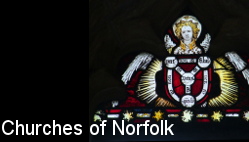
home I index I introductions I e-mail I about this site
St Edmund, Thurne
Follow these journeys as they happen at Last Of England Twitter.
| St
Edmund, Thurne The village shares its name with the river its sits beside, and perhaps the name is strange, because Thurne is the Old English word for a thorn bush. In this remote parish which seems as much water as it does land, perhaps that is how the place was identified by those travelling by boat through these marshes, a thorny place. Coming down from the top road, the narrow lanes roll into the surprise of a fairly busy village in summertime thanks to the boats. There's a popular pub down towards the staithe, but St Edmund is on the hillside above the village, out in the fields. From the bank across the road you look down on Thurne windmill, with the ruined Abbey of St Benet in the haze beyond across the river. The occasional white sail of a boat slips through the landscape. I came back here in the late summer of 2022, the trees restless and the dust from the harvest suffusing the air. The sweet sadness I feel every year as the nights begin to draw in was magnified here in the late afternoon. As you would expect around here, the church is small and simple. It seems pretty much all a rebuilding of the early 14th Century, with necessary repairs and restorations making themselves felt in the late 15th Century and then again in the 1840s, an early date of a 19th Century restoration in Norfolk, so it must have needed it. Both nave and chancel run together under thatched roofs with just a gable to separate them, otherwise there is no division. One curiosity is that there is a long, circular squint which runs eastwards from outside through the western wall of the tower, lining up on the altar in that direction, and on St Benet's Abbey in the other. Was to create a kind of sacramental connection between the two? When I first visited here back in 2008 a pigeon had nested inside it, as you can see in the photograph at the bottom of this page. And as you'd expect, you step into a plain and simple interior, obviously well-loved and looked after. Looking up into the chancel, it is a perfect setting for the jewel in the crown of this church, the east window by Martin Travers depicting St Mary Magdalene meeting the Risen Christ in the garden. On either side, roundels to St Edmund and the Blessed Virgin are typical of Travers' elegant confidence. It would be interesting to know how the work of such a major artist came to be commissioned by such a small and remote parish. The low cut bowl of the font appears to be in the 14th Century Decorated style - or is it a 19th Century reimagining? If so, it's a very good one. In 1489 one one William Reed left twenty shillings to the reparation of the roodloft. The roodloft has long since gone of course, as has the screen, but the rood beam remains. This was where the candles would be placed to flicker in front of the rood group. The sanctuary beyond would have been railed in at the start of the 17th Century by edict of the ill-fated Archbishop Laud, and the rails here appear to be contemporary with that order. It would be interesting to know if they remained in situ in the two centuries afterwards. And so, that was it. My next visit to Norfolk would be in autumn, for the summer was almost over. All over the Broads, the last fortnighters, weekers and weekenders would be steering their boats back into Wroxham, Potter Heigham and Ludham, and setting off home for the Midlands towns. The countryside would be stripped of its riches, to lie empty under the lowering skies. The earth would be turned like rich fruit cake, and the skeletons of trees, which had seemed so full of green abundance just a few weeks before, would be a stark punctuation across the land. Breathing in the cooling air of the late afternoon, I could already sense Norfolk closing in on itself again, settling down in quiet solitude for the onset of winter, darkness falling increasingly swiftly across the bare fields. Simon Knott, October 2022 Follow these journeys as they happen at Last Of England Twitter. |
|
|||||||||||||||||||||||||||||||||||||||||||||||||||||||
home I index I latest I introductions I e-mail I about
this site I glossary
Norwich I ruined churches I desktop backgrounds I round tower churches
links I small
print I www.simonknott.co.uk I www.suffolkchurches.co.uk